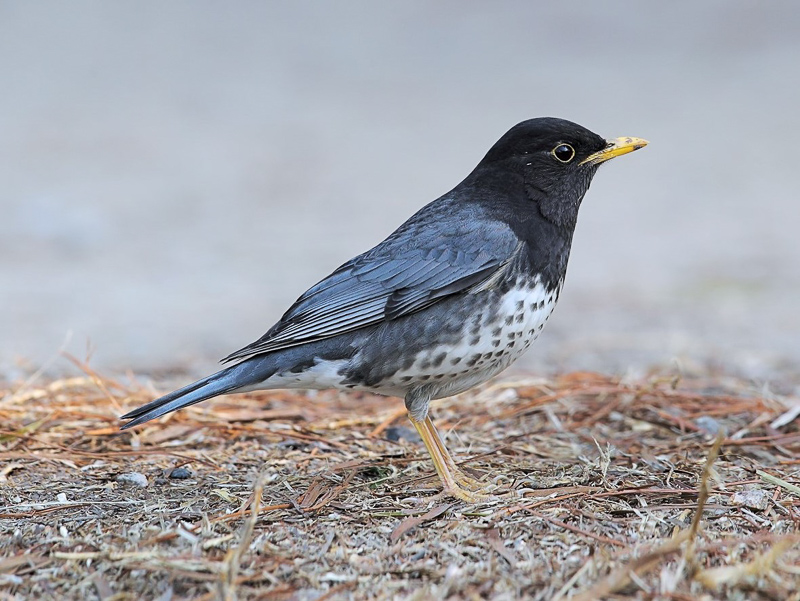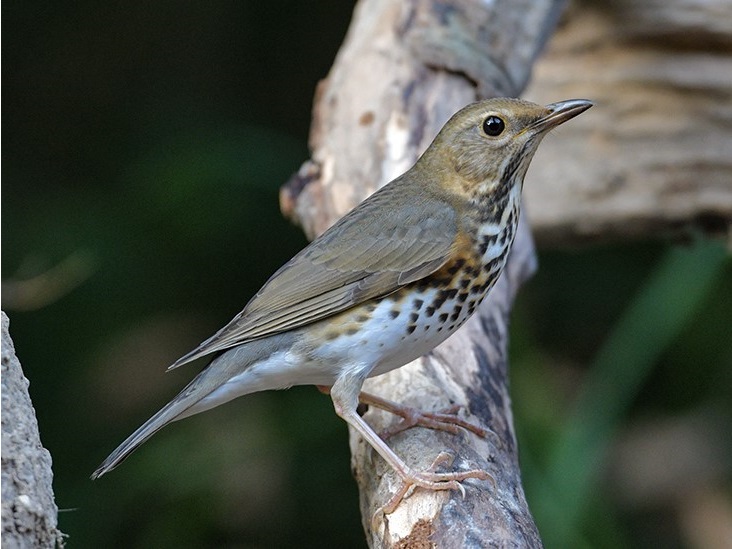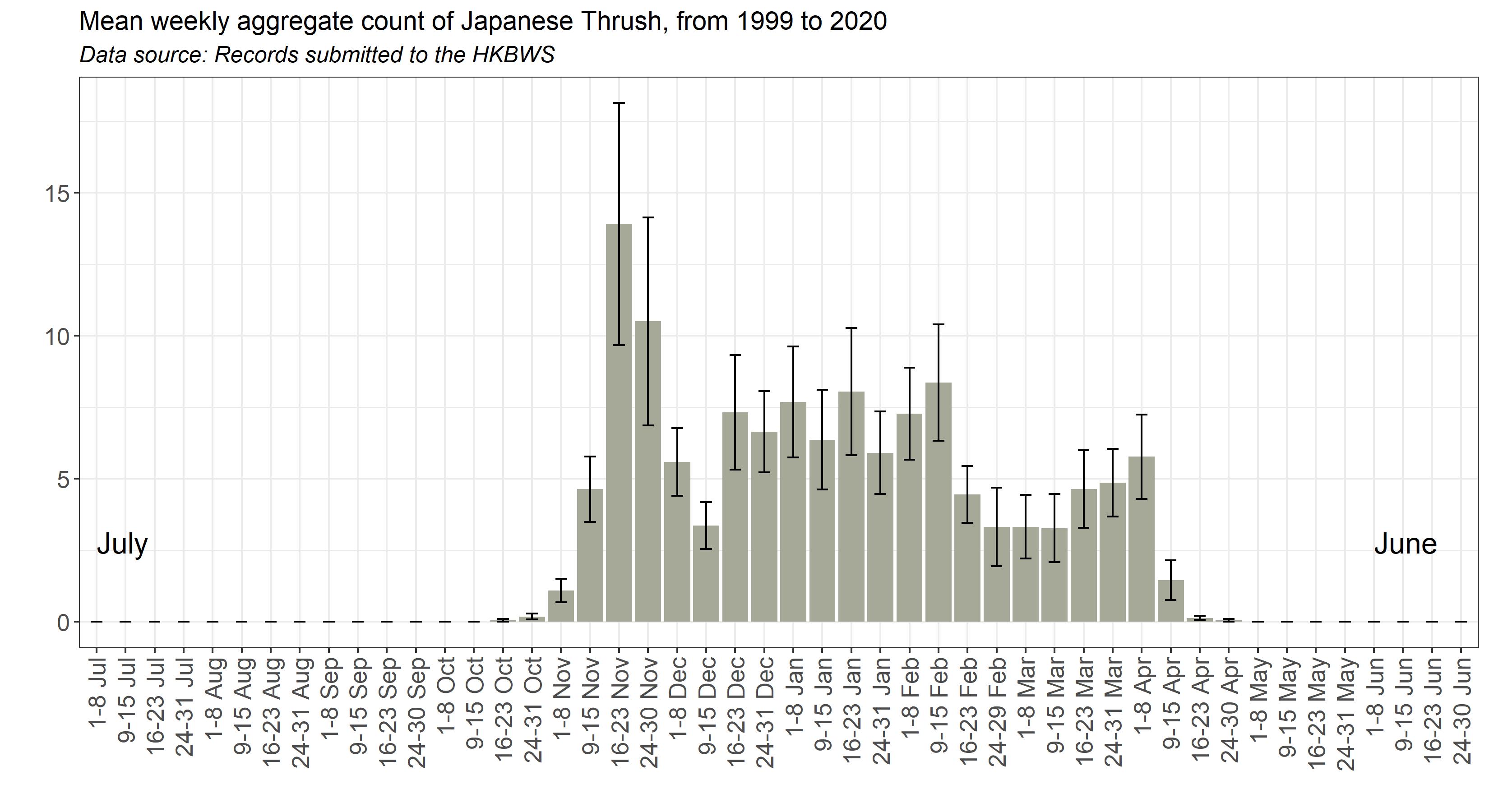Japanese Thrush Turdus cardis 烏灰鶇
Category I. Common winter visitor and passage migrant to open and closed-canopy wooded areas. May have declined since the 1960s and 1970s.
IDENTIFICATION

Jan. 2011, Michelle and Peter Wong. Adult male.
21-22 cm. Adult males have slate grey head and chest that shows obvious contrast with the mid bluish-grey upperparts and tail, and greyish flanks with large spots of the same colour on the belly. The bill is largely yellow. Occasional birds lack spotting on the underparts.

Nov. 2022, Guy Miller. Adult female.
Adult females are grey-brown above with whitish underparts that are heavily spotted grey on the chest and flanks and have an orange wash on the upper flanks. This bird is less spotted below than many in HK. First-year females have pale tips to the greater coverts and tertials.

Nov. 2019, Guy Miller. First-winter male.
First-year males are variable, though this may also reflect geographical variation, as mainland China birds have been reported to show more marked contrast between the head and upperparts. Some first-years are similar to adults but with retained juvenile browner flight feathers and some greater coverts.

Dec. 2020, Guy Miller. First-winter male.
Others are rather uniform with little contrast between the greyish head and upperparts and flight feathers and have fairly dense spotting over much of the underparts. Birds breeding in Japan are said to be darker and more uniform above.
VOCALISATIONS
The high-pitched sibilant slightly buzzing flight calls of this and other Turdus thrushes are a distinctive feature of woodlands in winter. Distinguishing the calls of different species is difficult; however, the typical flight call of Japanese Thrush tends to be slightly lower in pitch than that of Grey-backed.
Alarm calls are extremely similar across Turdus thrushes in HK.
DISTRIBUTION & HABITAT PREFERENCE
Japanese Thrushes frequent forests, fung shui woodland and more lightly-wooded areas, including urban parks with sufficient ground cover. It usually occurs singly or in small parties of up to five birds, and often in mixed parties of other Turdus thrushes.
OCCURRENCE
Figure 1 illustrates the pattern of occurrence of Japanese Thrush from 1999 to 2020 and indicates it is generally present from the second week of November to the first week of April. Extreme dates are 25 October 1970 and 8 May 1960. Peak numbers occur in the second half of November indicating passage occurs. Relatively consistent numbers from the third week of December to the middle of February indicate a settled winter population, after when there is a decline to mid-March. An increase in numbers in the second half of March and first week of April indicates spring passage, though this is usually weak.
There may have been a decline in relative numbers compared to Grey-backed Thrush since the 1960s. During the MAPS project of 1966-67 (McClure and Leelavit 1972), 34 Japanese Thrushes were caught on The Peak compared to only 30 Grey-backed Thrushes. Based on the number of records submitted to HKBWS from 1999 to 2020, Japanese Thrush is now encountered only half as often as Grey-backed Thrush.
The highest count in recent years is of 85 on 21 November 2019 on Lamma at a small pond set up to attract birds for photography; the highest count in more typical birding activity is of 56 on 25 November 2009 on Po Toi, including 41 passing over early morning. In the 1960s and 1970s when observer coverage was much lower than it is now, parties of up to 20 birds were sometimes recorded, the highest counts being 40 at Bethanie, Hong Kong Island on 1st and 8 February 1969 and 30 at Po Shan during 5-7 January 1971. This may indicate typical numbers are lower now.
Recorded by Swinhoe (1861) in February and March, Kershaw (1904) noted it to be common in winter; Vaughan and Jones (1913), however, stated it was not very common, although numbers were higher in spring due to the passage of migrants, a view supported by Herklots (1953).
BEHAVIOUR, FORAGING & DIET
Frequently seen at fruiting trees and shrubs, including Ilex rotunda var microcarpa, Machilus thunbergi, Schlefflera heptaphylla, Osmanthus matsumuranus, and Celtis sinensis. Also forages in leaf litter for invertebrates, apparently more so early morning and evening. Flights of Turdus thrushes from overnight roosting sites to foraging areas are a feature of wooded areas. Very early morning and at dusk birds may be seen foraging on forest paths.
RANGE & SYSTEMATICS
Monotypic. There are two breeding populations, one throughout Japan and the second in central China reaching to the east coast; winters south China into northeast Indochina (Collar and Bonan 2020, Liu and Chen 2020).
CONSERVATION STATUS
IUCN: Least Concern. Population trend unknown.
Figure 1.

Collar, N. and A. Bonan (2020). Japanese Thrush (Turdus cardis), version 1.0. In Birds of the World (J. del Hoyo, A. Elliott, J. Sargatal, D. A. Christie, and E. de Juana, Editors). Cornell Lab of Ornithology, Ithaca, NY, USA. https://doi.org/10.2173/bow.japthr1.01Dove, R.S. and H.J. Goodhart (1955). Field observations from the Colony of Hong Kong. Ibis 97: 311-340.
Herklots, G. A. C. (1953). Hong Kong Birds. South China Morning Post, Hong Kong.
Kershaw. J. C. (1904). List of birds of the Quangtung Coast, China. Ibis 1904: 235-248.
Liu, Y. and Y. H. Chen (eds) (2020). The CNG Field Guide to the Birds of China (in Chinese). Hunan Science and Technology Publication House, Changsha.
Swinhoe, R. (1861). Notes on the ornithology of Hong Kong, Macao and Canton, made during the latter end of February, March, April and the beginning of May 1860. Ibis 1861: 23-57.
Vaughan, R. E. and K. H. Jones (1913). The birds of Hong Kong, Macao and the West River or Si Kiang in South-East China, with special reference to their nidification and seasonal movements. Ibis 1913: 17-76, 163-201, 351-384.

